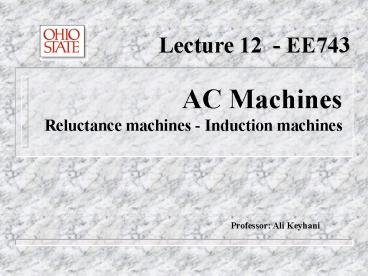Lecture 12 EE743 - PowerPoint PPT Presentation
1 / 17
Title:
Lecture 12 EE743
Description:
Stator windings are assumed to be sinusoidally distributed ... rotating mmfs (These motors are used in clocks and some other turntables) ... – PowerPoint PPT presentation
Number of Views:51
Avg rating:3.0/5.0
Title: Lecture 12 EE743
1
Lecture 12 - EE743
AC Machines Reluctance machines - Induction
machines
Professor Ali Keyhani
2
Two-Pole reluctance machines
bs axis
?r
?r
as
as'
?r
?r
as axis
as axis
bs
bs'
as
as
Single phase
Two phase
3
Two-Pole reluctance machines
- Stator windings are assumed to be sinusoidally
distributed - For single phase machines excited by an AC
current source, the generated flux wave has two
opposite rotating mmfs (These motors are used in
clocks and some other turntables)
4
Two-Pole reluctance machines
- term results in
counterclockwise (positive) travelling wave - term results in
clockwise (negative) travelling wave
5
Two-Pole reluctance machines
- For reluctance machine (Fig. 1),
6
Two-Pole reluctance machines
- For two-phase reluctance machines (see Fig.1),
only one constant-amplitude rotating air gap mmf
is produced during balanced steady state
conditions - Two-phase reluctance machines develop a constant
torque at synchronous speed rather than a torque
which pulsates about an average value as is the
case with single-phase machines
7
Two-pole induction machines
bs axis
br axis
?r
ar axis
?r
?r
?r
as'
ar axis
as'
?r
?r
ar'
?s
?s
br
ar'
as axis
as axis
bs
bs'
ar
br'
ar
as
as
Single phase
Two phase
8
Cutaway Views of Squirrel-cage Induction Motor
9
Two-pole induction machines
- Single and two pole induction machines have
identical equivalent orthogonal windings which
are sinusoidally distributed (see Fig.2) - Rotor windings are short-circuited
- Single-phase induction machines are widely used
(washers, dryers, furnace fans, etc.) - Recall
10
Two-pole induction machines
- Term 1 positive travelling flux wave
- Term 2 negative travelling flux wave
- Recall
- Single-phase induction machines do not develop a
starting torque. At the start ?r0, Te0, i.e at
start the rotor cannot follow either of the
rotating mmfs since it develops as much torque to
go in either direction - Single-phase induction motors have two stator
windings with provision to switch out one of the
windings once the rotor accelerates to between 60
to 80 percent of synchronous speed
11
Two-pole induction machines
- To provide two phase power from one phase power
supply, a capacitor is used during the starting.
12
Two-pole induction machines
- For two-phase induction machines, statormmfs
is a positive travelling flux wave which rotates
around the air gap at a speed of ?e (see Fig.2b) - Machine rotor windings are short-circuited
13
Two-pole induction machines
- Current flowing in the rotor windings will be due
to induction with a frequency of ?e - ?r. The
rotor currents, iar and ibr will produce an air
gap mmf that travels at a speed of ?e - ?r
relative to the rotor or ?e relative to a
stationary observer. - Interactions of mmfr due to rotor and mmfs due to
stator will produce torque on the rotor.
14
Three-phase induction machines
bs - axis
br - axis
as'
?r
Te
?r
bs
cs
ar - axis
ar'
br
?r
Tl
?s
cr
as - axis
cr'
br'
ar
cs'
bs'
as
cs - axis
cr - axis
15
Three-phase induction machines
- Three-phase induction machines have three
identical sinusoidally distributed stator and
rotor windings. The magnetic axes of the windings
are displaced 120o from each other and rotor
windings are short-circuited (see Fig.3)
16
Three-phase induction machines
- mmfs is a positive travelling flux wave which
rotates around the air gap at a speed of ?e. - mmfr is a positive travelling flux wave which
rotates around the air gap at a speed of ?e-?r
relative to the rotor. - Interactions of mmfr due to rotor and mmfs due to
stator will produce torque on the rotor.
17
Three-phase induction machines - dq axis
bs - axis
br - axis
q - axis
?r
ar - axis
?
?
?r
?s
as - axis
d - axis
cs - axis
cr - axis































